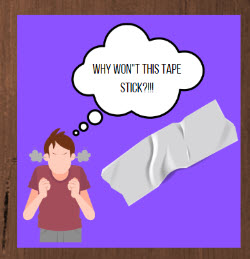
Let's talk about adhesive tape that is touted to stick to plastic sheeting (polyethylene sheeting) that is commonly used in various industrial applications. The tape is designed to adhere to a variety of substrates, including metals, plastics, and other materials. However, in some cases, the tape may not stick well to polyethylene surfaces. There are several reasons why this could happen:
-
Low surface energy: Polyethylene has a relatively low surface energy, which means that it can be difficult for adhesives to bond to it. This can make it challenging for some tapes to adhere to polyethylene surfaces.
-
Surface contamination: If the surface of the polyethylene is contaminated with oils, dirt, or other substances, this can interfere with the ability of the tape adhesive to bond to the surface. Even small amounts of contamination can prevent the adhesive from forming a strong bond.
-
Incompatible adhesive chemistry: Certain fire retardant tape are designed to work with a range of substrates, but it may not be compatible with all types of polyethylene. If the tape adhesive chemistry is not compatible with the particular type of polyethylene used, it may not adhere well to the surface. When slip or other processing aids are used, they make the surface of the polyethylene more slippery, so it slides through the manufacturing equipment more easily, and can be run much faster. But it remains on the surface on a microscopic level, and makes it more difficult for tape to adhere well. By nature, the surface of the polyethylene is smooth and slippery, so many tapes do not adhere well, even when no processing aids are used.
-
Temperature and humidity: The environment in which the tape is applied can also affect its ability to bond to polyethylene. If the temperature or humidity is too high or too low, this can interfere with the curing process of the adhesive, which can prevent it from forming a strong bond. The temperature of the tape when applied also affects the adhesion level. Tape should be applied at room temperature if possible. The cooler the temperature, the lower the adhesion. How smooth the finish is for each production run varies depending on temperature and humidity in our manufacturing facility. The smoother the finish, the harder it is for the tape to adhere.
- Pressure during Installation: Tape is pressure sensitive. The more pressure used during installation, the higher the adhesion. And the adhesion increases as the adhesive wets out on the surfaces being bonded. The higher the initial pressure, the better the final bond.
- Density Range: The polyethylene has a density range. At the lowest end of the range it is less smooth than at the highest end of the range. This varies with every batch of resin, and every production run.
- The Solution: To improve the adhesion of certain tapes to polyethylene surfaces, it may be necessary to prepare the surface by cleaning it thoroughly and using a primer or other surface treatment to increase its surface energy. Additionally, selecting a different tape formulation or adhesive chemistry may be necessary if the tape is not compatible with the particular type of polyethylene being used.
As you can see, a number of factors may come into play as to why a tape is not sticking to polyethylene plastic sheeting.

